

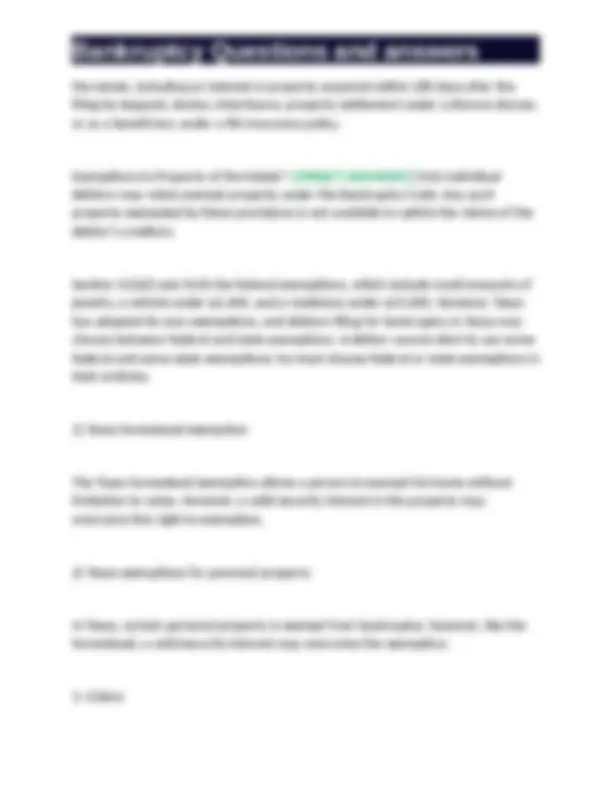
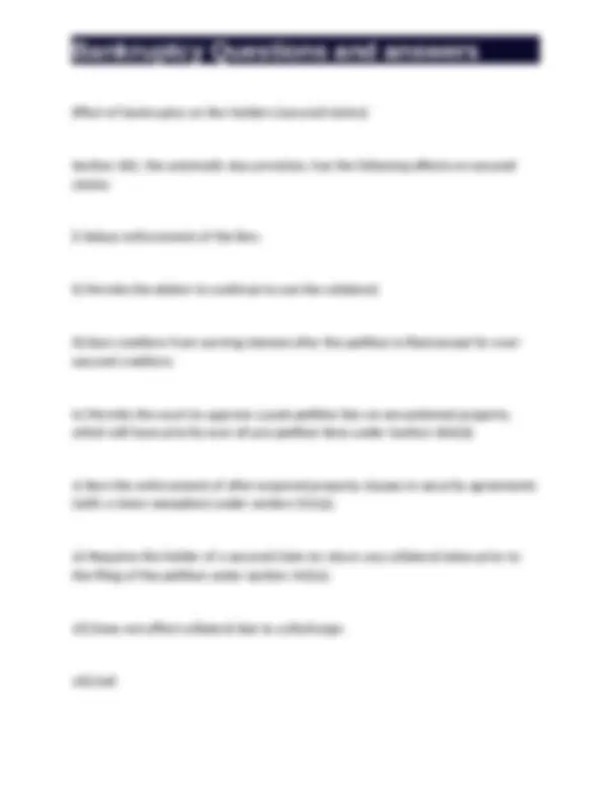

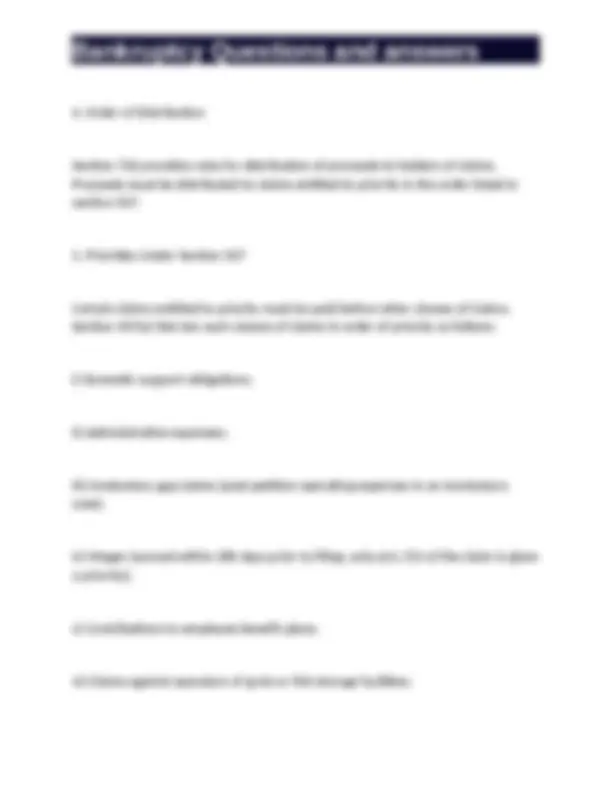

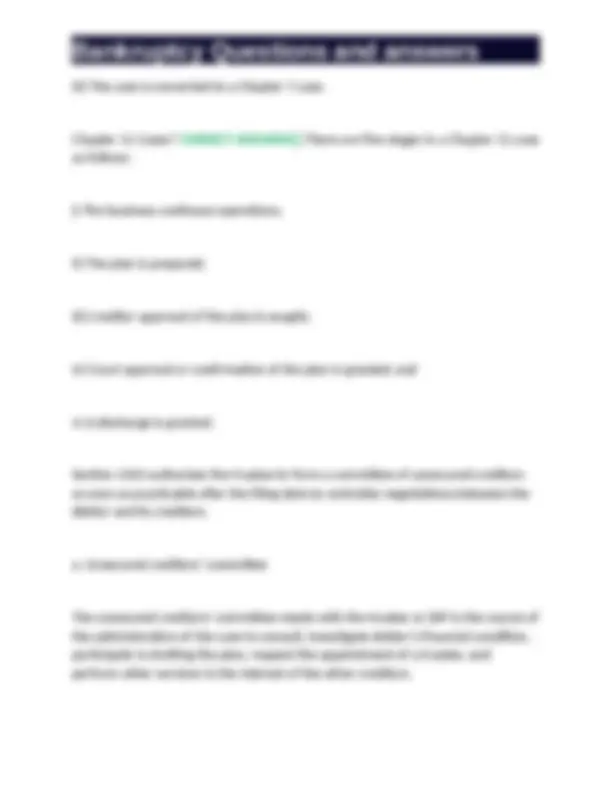


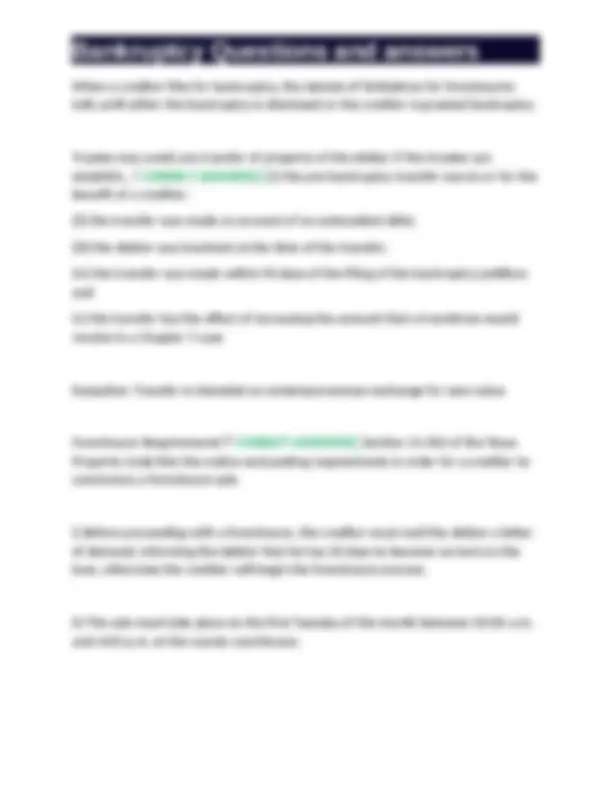



Study with the several resources on Docsity

Earn points by helping other students or get them with a premium plan


Prepare for your exams
Study with the several resources on Docsity

Earn points to download
Earn points by helping other students or get them with a premium plan
Community
Ask the community for help and clear up your study doubts
Discover the best universities in your country according to Docsity users
Free resources
Download our free guides on studying techniques, anxiety management strategies, and thesis advice from Docsity tutors
A detailed analysis of the policies, types of relief, and claims in bankruptcy cases. It covers the overarching policies under the bankruptcy code, the three main types of bankruptcy relief, and the various types of debts that are non-dischargeable. It also discusses the effect of bankruptcy on lien holders, repayment of secured claims, and the order of distribution of proceeds to holders of claims. The document also explains the roles and duties of trustees, committees of unsecured creditors, and the avoidance provisions in bankruptcy.
Typology: Exams
1 / 19

This page cannot be seen from the preview
Don't miss anything!












Types of Relief for debtors? CORRECT ANSWERS✅ (i) liquidation and (ii) reorganization or rehabilitation. a. Chapter 7 Chapter 7 (Liquidation) is the most common type of bankruptcy relief sought. Businesses and individuals seek relief under Chapter 7, which involves the potential liquidation or sale of the debtor's assets by a trustee to pay the claims of the debtor's creditors in accordance with the provisions of the Bankruptcy Code. b. Chapter 11 Chapter 11 (Reorganization or Rehabilitation) is the type of bankruptcy relief sought mostly by business organizations, such as corporations and partnerships, but sometimes by individuals. This type of bankruptcy relief typically permits debtors to retain their assets to generate earnings that are used to fund a plan of reorganization to pay their creditors. The creditors' debts are usually extended, reduced, or otherwise adjusted in the plan thereby allowing the debtors to avoid liquidation and the closure of their business. c. Chapter 13 Chapter 13 (Reorganization for Individuals) is the type of bankruptcy relief sought by individuals with regular income to retain their assets (and thereby avoiding liquidation) while generating earnings that are used to fund a plan to pay their creditors.
Policies of Bankruptcy Code? CORRECT ANSWERS✅ There are three overarching policies under the Bankruptcy Code: (i) equality of distribution, (ii) adequate protection of an interest in property, and (iii) a fresh start for the debtor. Who is entitled to a discharge?? CORRECT ANSWERS✅ In Chapter 7 cases, corporations and other business entities (other than a sole proprietorship) cannot receive a discharge, but individuals can. Furthermore, Chapter 7 provides 11 separate grounds for denying an individual a discharge when the debtor has engaged in some form of pre-petition or post-petition misconduct. In Chapter 11 cases, section 1141(d) generally discharges the debtor upon approval (i.e., confirmation) of the plan. Actual payment to the creditors is not required for corporations and other business entities (other than a sole proprietor) to obtain a discharge. However, completed payments under the plan is required for individuals (including those who operate a business as sole proprietors) to receive a discharge. In Chapter 13 cases, individual debtors receive a discharge under section 1328 after the plan is confirmed, all payments are made under the plan (except in a hardship situation), and the debtor completes a course on personal financial management. Which debts are non-dischargeable? CORRECT ANSWERS✅ i) Tax claims; ii) Debts incurred by fraud; iii) Certain debts relating to luxury goods or services;
the estate, including an interest in property acquired within 180 days after the filing by bequest, devise, inheritance, property settlement under a divorce decree, or as a beneficiary under a life insurance policy. Exemptions to Property of the Estate? CORRECT ANSWERS✅ Only individual debtors may retain exempt property under the Bankruptcy Code. Any such property exempted by these provisions is not available to satisfy the claims of the debtor's creditors. Section 522(d) sets forth the federal exemptions, which include small amounts of jewelry, a vehicle under $2,400, and a residence under $15,000. However, Texas has adopted its own exemptions, and debtors filing for bankruptcy in Texas may choose between federal and state exemptions. A debtor cannot elect to use some federal and some state exemptions; he must choose federal or state exemptions in their entirety.
Effect of bankruptcy on lien holders (secured claims) Section 362, the automatic stay provision, has the following effects on secured claims: i) Delays enforcement of the lien; ii) Permits the debtor to continue to use the collateral; iii) Bars creditors from earning interest after the petition is filed except for over- secured creditors; iv) Permits the court to approve a post-petition lien on encumbered property, which will have priority over all pre-petition liens under Section 364(d); v) Bars the enforcement of after-acquired property clauses in security agreements (with a minor exception) under section 552(a); vi) Requires the holder of a secured claim to return any collateral taken prior to the filing of the petition under section 542(a); vii) Does not affect collateral due to a discharge; viii) Exti
i) Property of the debtor becomes the property of the estate; ii) The automatic stay protects the property of the estate and the debtor from collection actions by creditors; and iii) The date of filing is the legally operative date for the commencement of the case. Can debtor seek relief under Chapter 7 or whether the debtor must seek relief under Chapters 11 or 13 because the debtor has the "means" to make meaningful payments to creditors.? CORRECT ANSWERS✅ Section 707(b) allows dismissal of a petition filed by an individual with primarily consumer debts under Chapter 7 for "abuse." Abuse may be found under the means test or when there is bad faith filing, or based upon the totality of the circumstances of the debtor's financial situation. The means test is applied if the debtor's monthly income is more than the state median. Under the means test, the court presumes abuse exists if the debtor's current monthly income reduced by debts and expenses, multiplied by 60 is not less than the lesser of (i) 25% of the debtor's non-priority unsecured claims, or $7,025, whichever is greater; or (ii) $11,725. If the presumption of abuse does not arise or is not rebutted by special circumstances, then abuse may still be demonstrated by bad faith or by examining the totality of the circumstances Conversion or Dismissal of a Case? CORRECT ANSWERS✅ 1. Debtor's Right A debtor may convert a case to Chapter 7 at any time provided the debtor satisfies the Chapter 7 requirements. If the case has not been converted from Chapter 7, 11, or 12, then the debtor may dismiss the case.
Upon the request of any party in interest or the trustee, the court may convert a case to Chapter 7 or dismiss the case for cause. Examples of cause include nonpayment of fees in connection with the case and the failure of the debtor to make timely payments under the plan of repayment.
vii) Consumer deposits (pre-payments; only $2,600 of the total claim is given a priority); viii) Tax claims; ix) Capital requirements of insured depository institution; and x) Personal injury claims resulting from intoxicated vehicle operation. [Discharge] Discharge of Ch 7 Cases? CORRECT ANSWERS✅ a. Parties entitled to discharge Section 727 denies a discharge to corporations and partnerships. Thus, only an individual may receive a discharge under Chapter 7. The 11 other objections to discharge apply to individual debtors and are aimed at fraud, dishonesty, or some form of improper conduct occurring either before or after the bankruptcy filing. For example, individual debtors are not entitled to a discharge when they (i) knowingly and fraudulently made a false oath or account in the case, (ii) fail to complete a course in personal financial management, and (iii) received a prior Chapter 7 discharge within the last eight years. b. Objections versus exceptions Section 523(a) lists 18 exceptions to debts otherwise permitted to be discharged, including taxes, domestic support obligations, and student loans. There is a difference between "objections to discharge" under section 727 and "exceptions
to discharge" under section 523. If an objection to discharge under section 727 is granted by the court, then this objection benefits all creditors because the debtor does not receive a discharge at all. On the other hand, if an exception to discharge under section 523(a) is granted by the court, this exception to discharge generally benefits only the creditor who proves that its claim is excepted from discharge. c. Reaffirmation agreement A reaffirmation agreement may be entered into between the debtor and a creditor of the estate whereby the debtor agrees to pay a pre-petition debt that would otherwise be subject to discharge in bankruptcy. The most common reason a debtor would enter into a reaffirmation agreement is to retain encumbered property, such as an automobile. Chapter 13 Cases Process? CORRECT ANSWERS✅ An individual debtor with a regular source of income: i) Proposes a plan of repayment; ii) Obtains court approval or confirmation of the plan; and iii) Remits payments over a period time of between three to five years.
iii) The case is converted to a Chapter 7 case. Chapter 11 Cases? CORRECT ANSWERS✅ There are five stages in a Chapter 11 case as follows: i) The business continues operations; ii) The plan is prepared; iii) Creditor approval of the plan is sought; iv) Court approval or confirmation of the plan is granted; and v) A discharge is granted. Section 1102 authorizes the trustee to form a committee of unsecured creditors as soon as practicable after the filing date to centralize negotiations between the debtor and its creditors. a. Unsecured creditors' committee The unsecured creditors' committee meets with the trustee or DIP in the course of the administration of the case to consult, investigate debtor's financial condition, participate in drafting the plan, request the appointment of a trustee, and perform other services in the interest of the other creditors.
b. Continuation of the debtor's business Section 1108 authorizes the continuation of the debtor's business unless the court orders otherwise. Typically, the DIP operates the business unless a request is made for a trustee to run the business and the court orders the appointment. Types of Actions for Bankruptcy Trustee? CORRECT ANSWERS✅ 1. Chapter 7 A trustee is appointed in every Chapter 7 case. The trustee's duties under section 704 may include the following: i) Collecting the property of the estate; ii) Contesting certain pre-bankruptcy and post-bankruptcy transfers of property of the debtor or of the estate; iii) Selling the property of the estate; iv) Objecting to improper creditor's claims; and v) If appropriate under section 704, objecting to the debtor's discharge.
ii) Resulted in a larger recovery of one creditor over other creditors; iii) Were not recorded in violation of state recordation statutes requiring notice to third parties; or iv) Were not timely recorded. Legal Consequences of Avoidance? CORRECT ANSWERS✅ The loser is the transferee against whom recovery is obtained by the estate. Thus, the consequence of avoiding a transfer is an increase in the property of the estate. If the trustee establishes the basis to avoid the transfer but is unable to recover the payment from the creditor, then any remaining claim by the creditor in bankruptcy is disallowed under section 502(d). If the trustee establishes a basis to avoid a mortgage on property of the estate, then the creditor loses its lien and is relegated to a creditor with an unsecured claim (i.e., without any encumbrance on the property). Under section 550(a), the court can also order recovery of the "value of the property" transferred, rather than the property itself. This provision permits recovery not only from the initial transferee but also from later transferees or from a person not the transferee but who benefited from the transfer. Types of Foreclosures in Texas? CORRECT ANSWERS✅ There are two types of foreclosures in Texas: judicial foreclosures and non-judicial foreclosures.
iii) Notice must be given at least 21 days before the sale by posting notice on the courthouse door, filing with the county clerk, and written notice by certified mail to each debtor. Notice by certified mail is complete when mailed.